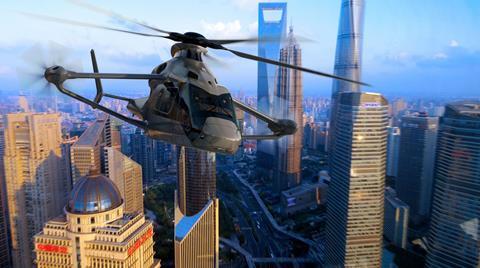Airbus Helicopters appears to be working on a new automated safety system for its high-speed Racer compound rotorcraft that would use its twin propellers to provide power to the main rotor in the case of a double engine failure.
The Racer demonstrator, which features twin pusher propellers mounted on V-shaped wings, is due to fly in 2022 and is part funded by the EU’s Clean Sky 2 programme.

Compound helicopters are designed to overcome the speed limitations of conventional rotorcraft, using propellers and a small wing to provide lift for high-speed flight, allowing the main rotor to be unloaded and slowed.
In addition, absent a tail rotor, the propellers also counter the torque effect from the main rotor.
Unfortunately, that extra complexity means a double engine failure is much harder to manage. While an autorotative landing is still possible in a compound helicopter, it presents a greater challenge to the pilot.
This is particularly true at high speed, where lowering the collective pitch of the rotor blades to maintain their rotation speed can generate substantial levels of vibration and high aerodynamic loads on the main rotor.
But Airbus Helicopters thinks it may have found a solution. According to the details of a European patent application – published on 25 August but filed in November 2020 – the system would automatically activate if the helicopter is travelling above a certain speed.
In that scenario, the pitch of the propellers would be reduced to a point “so that each propeller no longer consumes power, but on the contrary provides motive power” to the transmission.
That would mean the rotation speed of the main rotor is slowed “as little as possible”, the patent says.
As an example, Airbus Helicopters says the propellers of a compound helicopter can each consume around 1,000kW of power, and the main rotor a further 500kW. Using its system, the propellers could be used to each provide 250kW to the main rotor, the application says.
But it notes that the overall powertrain, notably certain gears, would need to be “sized to support the reversible function” of the system.
In addition, because the system activates automatically, “the speed of rotation of the lift rotor does not drop immediately and rapidly following the engine failure”.
This, it says, reduces pilot workload and gives the option of either slowly decelerating the aircraft until a normal autorotation can be initiated, or diving the helicopter to maintain forward speed.
At lower forward speeds, the system would instead automatically lower the collective pitch of the main rotor and adjust the pitch of the propellers to provide only enough thrust to counter any torque-induced yaw movement.
Automated systems would also work to maintain rotor or propeller speeds at the required levels, while also providing the pilot with sufficient control to safely land the helicopter, the patent application says.
Although the application does not mention the Racer by name, it says the project that led to the airframer’s invention was funded by the Clean Sky 2 programme.


























